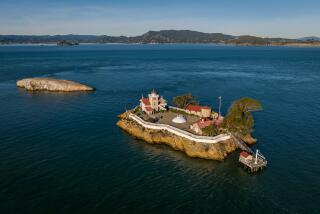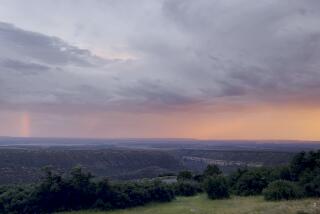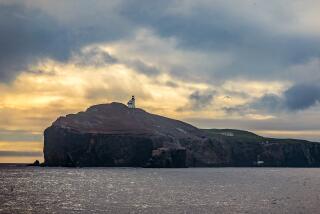From the Reef to the Rain Forest in Queensland
CAIRNS, Australia â It is said that the Great Barrier Reef is the only living entity that can be seen with the naked eye from outer space. Stretching in lazy arcs along the Queensland coast of Australia, it is a series of islands, atolls and underwater shoals, of crystal water and spectacular marine life, including one of the largest coral collections in the world.
For me it was like a fairy tale remembered from childhood: half fantasy, half real. So when I learned that I would be in Sydney on business, I arranged to make my own personal pilgrimage, and while I was at it, to check out some very special lodges, one on the reef and one on the mainland.
Lizard Island
Of everything I read in preparation for my trip to Australiaâs legendary Great Barrier Reef, my favorite sentence was, âThere has never been a recorded unprovoked shark attack on a scuba diver in Queensland.â
At that moment I determined that if I chanced upon a shark, I would take great care not to provoke it, and at all times I would be accompanied by someone taking notes.
It was with those thoughts in mind that I hesitantly slipped into the transparent blue sea surrounding an island called Lizard off the Queensland coast of Australia.
The departure point for Lizard Island Lodge earlier that day had been the town of Cairns, three hours north, by jet, from Sydney. There, a half dozen of us boarded a 16-seat twin-propeller airplane for the flight to the island of the same reptilian name. For an hour we bounced and skidded through a heavy rain storm. But occasionally I could glimpse, through breaks in the clouds, the Great Barrier Reef far below. To my chagrin, it was not very attractive, a light blue Jackson Pollack spattering of random shapes set against a dark blue background.
We landed on a tiny air strip and were whisked to the main lodge building, where a light lunch and cool drink were waiting on a lovely long dining porch open to sweeping sea views. In the lounge, two American accents and two Australian were discussing a video about marlin fishing. Over the semi-arid island the sky still glowered and drops still fell but I was not there to sit in my room, so I jumped into my bathing suit, walked the few yards to the beach, slipped on my snorkeling gear and took the plunge. Thus I found myself in the sea off Lizard, alone.
I dove and swam underwater above a small meadow of waving brown tendrils. That they were soft coral, I knew, but were these the living corals the reef was famous for? I didnât think so. A little further on, I dove again into a different landscape, a jumble of coral tubes and balls, cones and fans, inhabited by fish of all shapes and sizes and colors. This was better, but still not quite up to my expectations.
And then I saw the clam. This was no larger-than-average New England quahog. This was a genuine, three-feet-across, Hollywood South Sea epic, stick-your-foot-in-it-and-youâre-a-goner giant clam. I truly was on the Great Barrier Reef.
On Aug. 11, 1770, English explorer Capt. James Cook had more terrestrial concerns, when he noted in his log: âThe only land-animals we saw here were lizards and these seemâd to be pretty plenty which occasioned my naming the island Lizard Island.â Thus began the recorded history of one of the few inhabited islands of the hundreds that dot more than 1,200 miles of the most celebrated reef in the world. The lizards that Cook referred to were not the cute little gekkos that scurry along the wooden walkways to the cottages, but great prehistoric goannas which still reside in certain untouristed spots. These are seldom seen by guests lounging under palm trees on the lawn that slopes to the beach, or those taking breakfast or lunch on the tropical-breeze-swept porch.
But other than that, little has changed on Lizard Island since it was named in 1770. There is a small air strip, a marine research facility, a cluster of small bungalows and the lodge, a low, peak-roofed building with wide verandahs facing the sea.
Inside the lodge one space flows into another, the cozy lounge to the small bar where guests gather before dinner to the elegant dining room whose louvered doors open on views of boats riding Anchor Bay.
The denizens of the deep are what bring most people to Lizard these days, and more than half of the resortâs guests come from America. Situated in one of the worldâs great fishing spots, the resort is booked to its 64-person capacity months in advance of the fishing season--September, October and November--when anglers descend to try for giant, 1000-pound-plus black marlin on boats chartered by the day.
The rest of the year they come for the diving--scuba and snorkeling--or just to relax on one of 24 beaches and secluded bays. Though many are rich and some are famous, Lizardâs guests appreciate the resortâs causal comfort and lack of pretension. In the evening when they gather at the bar or later in the spacious dining room, the feel is much like a private club where even the newest arrival is welcomed as a member.
Needless to say, this private club does not come cheap. (Howâs $660 a day for two?) The entire 2,500 acre island is a national park, and Australian Airlines leases and runs the only lodge, Lizard Island. Because the climate wreaks havoc with wood, the suites are simply but tastefully furnished, with dove-grey walls, king-size beds, and just the essential couches, dressers and chairs. Bathrooms are large but not ornate, and all 32 porches look past palms and casuarina trees to the bay.
In fact, what impresses most is the service. With two in staff for every three guests, wishes are fulfilled as if by magic, whether itâs raising sail on one of the catamarans, outfitting for a snorkel on the barrier reef, or preparing a picnic hamper--including a bottle of chilled, vintage wine--for lunch in a private cove where the only footprints on the sand are those of the birds.
The morning after my rainy arrival, we motored in a cabin cruiser to Cod Hole under a pure blue dome of cloudless sky. Donning fins and mask, I dropped into a pocket of reef where I fed little fish to big fish--150-pound potato cod and Maori Wrasses--and played peek-a-boo with a seven-foot moray eel named Merlin. Of the 1,600 species of fish that inhabit the reef, most seemed to be here, flashing their gaudy colors like an aquarium on parade.
On the other, far side of the coral divide, where the wall dropped sheer for hundreds of feet, were the giants: the manta rays, sharks and whales. On this side were the angels and butterfish and clowns.
But of sharks there were none, although I looked, believe me, I looked.
Silky Oaks
Returning to Cairns, I headed from the reef to the rain forest. An hour inland on a local bus took me to the tiny community of Mossman, where a van was waiting to shuttle me--a five-minute ride--on to Silky Oaks Lodge, which sits alone at the edge of Daintree National Park.
âCassowary, Platypus, Kookaburra,â and for me, âPossum.â These were some of the names of the identical timber cabins which, if it werenât for a honeymoon couple posing for pictures on their private balcony, would have looked for all the world like an upscale summer camp.
But not quite.
Few summer camps serve fine wines and gourmet food, or have pet kangaroos hopping around the lawn, or sit on the edge of a national park whose environs have lain undisturbed since the passing of the last ice age.
Before long, I was hiking in a primeval rain forest on a beautifully maintained, easy-to-walk trail. The smell was of rich humus and the air was so heavy I could hold it in my hands. On either side were giant ferns and twisted vines and all those species relegated in the States to glass conservatories for tropical plants.
With no company but the nearby rushing of the Mossman River, I felt completely alone until suddenly there was a crash and an ungainly bird rose from the brush and flapped noisily away.
âIt was a wild turkey,â said Moss Hunt who, with his wife Theresa, owns and manages Silky Oaks.
âThey build their nests close to the trail,â he continued. âWe have dingos, mountain wallabees, tree-climbing kangaroos. Gliders (flying foxes), too, but youâre not going to see them if you donât go looking. The canopyâs 200 to 300 feet high. Thatâs where they are.â
A committed environmentalist, Moss is on the board of the World Heritage Foundation. His love of nature is shared by Theresa, who has been mother to over 30 orphaned wallabees and kangaroos.
The bag I saw one of her charges nuzzling is a pouch sheâd had made of fleece-lined fabric and hung from a branch. âThatâs a replacement for his motherâs pouch,â she explained. âHe goes in and out all day. Without it a joey (baby kangaroo) will fret to death within 24 hours.â Theresa also discovered that the babies require low lactose milk and hand feeds them with a special formula. âThey need to be loved. Just like caring for a child.â
After eight years as managers of Lizard Island, the Hunts came inland because they were looking for a change. âWe wanted the sort of place we would like to come to on our holidays. There were no âboutique resortsâ ten years ago, so we built our own.â
They found their Utopia between a river and a mountain and built a long, open restaurant among the trees that gave Silky Oaks its name. Then came the cabins, 20 of them. Each roomy interior is simple and rustic, finished entirely with polished woods. Muted prints drape the windows, and louvers let in cool evening breezes and the sounds of nature while screens keep out the nasties. Perhaps best of all are the spacious verandahs where you sit above the river and blissfully blend with your surroundings. This is what âpeacefulâ is all about.
Silky Oaks is for those who want to do very little or quite a lot. Two can do the former for about $250 a day. The latter costs a bit more. Itâs possible to simply set anchor and lounge by the pool and wait for your stomach to announce lunch or dinner. Much better, in my humble opinion, is to sign on for a day tour to the Great Barrier Reef (unless youâve just come from Lizard Island as many guests have) or to take one of Moss Huntâs wilderness safaries.
Led by naturalist guides, they depart daily, rain or shine (they donât call them rain forests for nothing) in four- and six-wheel vehicles with thickly padded seats. The safaris begin in a highly civilized fashion, with tea at the lodge and a petting session with the babies. The rest of the day is more primitive.
After a half hour on a country road, the vans take a rutted path into Daintree National Park. They careen past crocodile-infested rivers, around waterfalls, through glades of tree ferns that are fossils in other parts of the world but still flourish here. The road winds under the shadow of Mt. Sorrow toward Cape Tribulation, both named by Capt. Cook on what must have been an off day. Finally, thereâs a walk on an isolated beach before retracing your tracks to Silky Oaks.
There, Civilization waits again with al fresco dining and congenial company. The wildlife is not far away, but on the dining porch itâs Cordon Bleu, applied to such regional items as succulent king tiger prawns. Not a bad mix of metaphors.
GUIDEBOOK
Two Queensland Resorts
Getting there: Both resorts are reached from Cairns. Australian Air jets from Sydney to Cairns (about three hours) for $185 one way. Twin-propeller planes, 17- to 18-seat Otters, fly from Cairns to Lizard Island ($216 round-trip). A private limousine is available for the hour-long drive from Cairns to Silky Oaks for $112 one way, or guests can take the public bus to Mossman for $20 and be picked up by the lodge.
Resorts: Resort reservations may be made through travel agents, or travel wholesalers specializing in Australian travel. Two of the latter are Los Angeles-based Swain tours, (800) 22-SWAIN, and Burbank-based Australian Travel Service (ATS), (800) 423-2880.
Lizard Island Lodge, PMB 40, Cairns, 4870, North Queensland, Australia.The lodge has 30 air-conditioned private suites and two deluxe suites. Suites per day, about $330 per person double occupancy; deluxe suites, about $340 per person double occupancy, including all meals and use of lodge equipment; scuba diving, snorkel trips, deep-sea fishing available at additional cost. For stays of seven days or more, somewhat lower rates are available.
Silky Oaks Lodge, P.O. Box 396, Mossman Gorge, 4873, North Queensland, Australia. Twenty private, air-conditioned cabins with private baths. Rates per day, about $240 per cabin, European plan; breakfast $5-$10, lunch $10-$20, dinner $20-$40. Australian Wilderness Safari rates are about $90 per person, including morning tea and lunch.
More to Read
Sign up for The Wild
Weâll help you find the best places to hike, bike and run, as well as the perfect silent spots for meditation and yoga.
You may occasionally receive promotional content from the Los Angeles Times.






